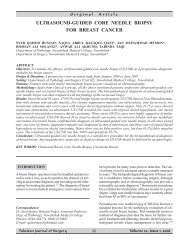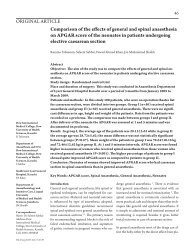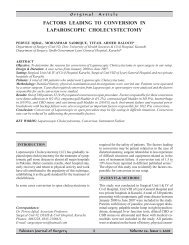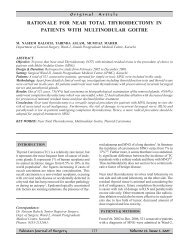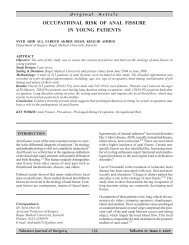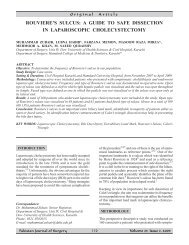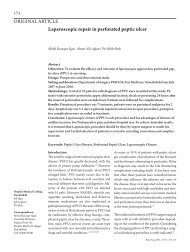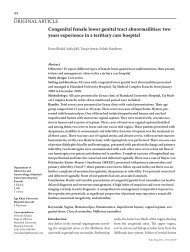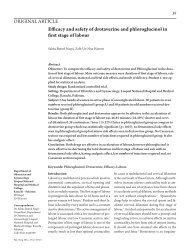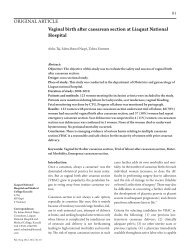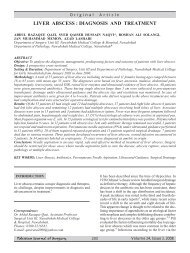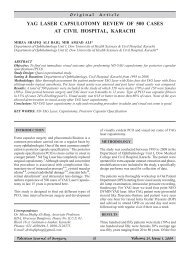Abruptio Placentae versus Placenta Previa as a risk factor for ...
Abruptio Placentae versus Placenta Previa as a risk factor for ...
Abruptio Placentae versus Placenta Previa as a risk factor for ...
- No tags were found...
You also want an ePaper? Increase the reach of your titles
YUMPU automatically turns print PDFs into web optimized ePapers that Google loves.
<strong>Abruptio</strong> <strong><strong>Placenta</strong>e</strong> <strong>versus</strong> <strong>Placenta</strong> <strong>Previa</strong> <strong>as</strong> a <strong>risk</strong> <strong>factor</strong> <strong>for</strong> Preterm Labourproblems and fetal death. <strong>Abruptio</strong> <strong><strong>Placenta</strong>e</strong> isvery frequently seen in our population; howeverlocal work on this important condition of pregnancyis very sparse.The <strong>risk</strong> of preterm delivery in placenta previa is41.1%. 6 Although the clinical course of placentaprevia is highly suggestive, the etiology of thiscondition is till remains obscure. The strongestconnection is found between previous history ofcesarean section, high parity, and advanced maternalage. 7 Other potential <strong>risk</strong> <strong>factor</strong> includehistory of previous spontaneous and inducedabortion 8,9 , previous uterine operations, previousplacenta previa 10 , smoking or substanceabuse during pregnancy 11 , multiple gestation. 12Diagnosis is made on history, clinical examinationand ultr<strong>as</strong>onography. Risk of preterm deliveryis incre<strong>as</strong>ed in women with APH who havesecond trimester vaginal bleeding or the presenceof uterine contraction. These facts highlightthe need <strong>for</strong> proper maternal care and thediagnosis of condition in all pregnant ladies especiallythose at high <strong>risk</strong>. So keeping these factsin view such c<strong>as</strong>es must be referred <strong>for</strong> deliveryat tertiary care hospitals where the trained personalsare available.Preterm birth occurs in 7-12% of all deliveries,but accounts <strong>for</strong> over 85% of perinatal morbidityand mortality. 13 Although the death rate h<strong>as</strong>decre<strong>as</strong>ed over the p<strong>as</strong>t few decades, this canbe attributed to improvements in the neonatalmanagements rather than a reduction in pretermbirths.The mortality, morbidity and costs of pretermdelivery are higher at lower gestational ages, <strong>for</strong>example, mortality rates are 90% at 23 weeksdropping to 2% at 34 weeks. Even in babies thatsurvive, there is a high <strong>risk</strong> of short and longterm morbidity. 14 Some <strong>as</strong>sociated conditionsare acute and amenable to treatment but otherssuch <strong>as</strong> cerebral palsy, neurodevelopment, andpulmonary disorders can result in long term, severedisability. There are also major implicationsin terms of the psychological and social impactof disability on the individuals and their carers.The dev<strong>as</strong>tating consequences of prematurity164have led to attempts to improve outcome by predicting,preventing and treating preterm labour.The study under discussion aims to determinethe frequency of preterm labour in APH andfetal outcome. This study will also identify theclinical <strong>risk</strong> <strong>factor</strong> <strong>as</strong>sociated with preterm deliveryin women with APH. Such in<strong>for</strong>mationwill <strong>as</strong>sist in future management of patient withAPH and women with <strong>risk</strong> <strong>factor</strong>s of second trimestervaginal bleeding and uterine contractionwill benefit from close surveillance in hospitaland repeated blood transfusion, so it will improvethe fetal outcome.Results:52 consecutive patients of APH due to abruptionplacentae and placenta previa were studiedin a period from May 23, 2006 to Jan 23, 2007in Gynae Unit II, Civil Hospital, Karachi. A predesignedpro<strong>for</strong>ma w<strong>as</strong> filled and later on analyzed.32 c<strong>as</strong>es of abruptio placentae and 20 patients ofplacenta previa were observed during the studyperiod. The total number of premature babieswere 15 (46.9%) in abruptio placenta comparedto 08 (40.0%) in placenta previa. Prematurityw<strong>as</strong> high in abruption placenta when comparedwith placenta previa. Distribution of gestationalages showed that 15 c<strong>as</strong>es (46.9%) were lessthan 37 weeks group and 17 c<strong>as</strong>es (53.1%) weregreater than 37 weeks group, while in patientsFigure 1: <strong>Abruptio</strong> placenta: distribution of patients accordingto outcome (n-32)50403020100Alive FSB IUD NNDKey: FSB-Fresh Still-birth, IUD-Intrauterine Death,NND-Erarly neonatal deathPak J Surg. 2010; 26(2):163-168



